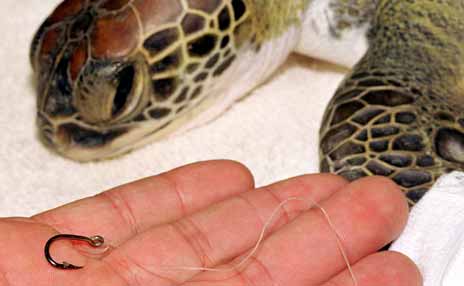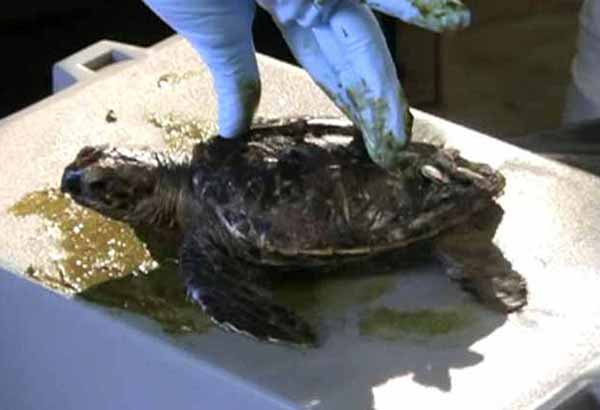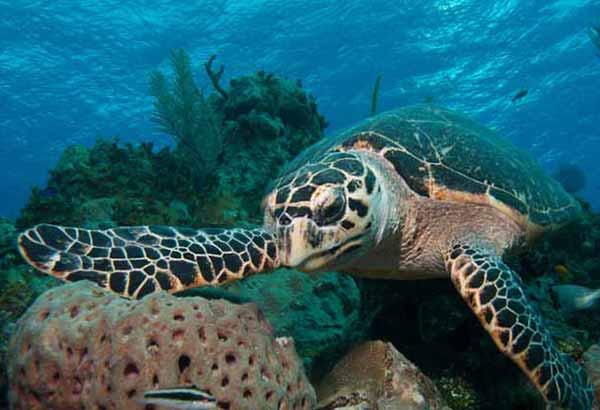Longevity
Once sea turtles reach sexual maturity, they may have an estimated reproductive life of about 30 years.
- Green sea turtles are the latest to mature and have an estimated reproductive life of about 19 years. Since they may take 40 years to mature, a lifespan of more than 60 years is feasible.

Natural Predators
Adult sea turtles have a few predators, mostly large sharks. Tiger sharks, in particular, are known for eating sea turtles. Killer whales have been known to prey on leatherback turtles.

Fishes, dogs, seabirds, raccoons, ghost crabs, and other predators prey on eggs and hatchlings. More than 90% of hatchlings are eaten by predators.

Flatback turtle nests are susceptible to predation by monitor lizards, dingoes, and introduced foxes.
Fibropapillomas
Sea turtles may develop wart-like tumors (fibropapillomas) on their skin and internal organs. These growths can reduce vision, obstruct normal swimming and feeding and increase susceptibility to secondary parasitism and infection.
- Fibropapillomas are most common in green turtle populations (especially in Hawaiian waters), although other sea turtle species are also susceptible.
Fibropapillomas may be at least partially caused by ocean pollutants. Unfortunately, a cure for fibropapillomas does not exist.

Natural Disasters
Hurricanes can severely impact sea turtle nesting success. Almost 90% of sea turtle nesting in the continental U.S. occurs on Florida's beaches. Scientists estimate that more than half of the sea turtle nests on the coast of Florida were washed away by the four hurricanes hitting the coast in 2004 and 2005.
During cold water events, when coastal water temperatures suddenly chill to below 10°C (50°F), sea turtles may become cold-stunned—floating at the surface and unable to swim.
Human Impact
Impact on nesting beaches.
- Some people illegally collect turtle eggs for food and for their alleged aphrodisiac effect.
- Kemp’s ridleys mainly nest on a remote beach in Mexico near the village of Rancho Nuevo (about 161 km, or 100 mi., south of the Texas border.) In 1947, scientists witnessed an arribadas of more than 42,000 Kemp’s ridley turtles in one day.
- In the 1960s numbers were reduced to less than 2,000 turtles. Although Kemp’s ridleys were protected in 1966 by the Mexican government, the population still plummeted to 2,000 by the 1960s and to less than 300 nesting females by 1986.
- Along with egg poaching and drowning in shrimp nets, coyotes and other predators also dug up many of the Kemp's ridley nests. Protective efforts involved protecting clutches of eggs, reductions and restrictions on shrimp trawling in the Gulf of Mexico, the use of turtle excluder devices (TEDs) in shrimp nets and a ban on sea turtle products in Mexico.
- In 2000, the Kemp’s ridley numbers began to slowly increase to a population of about 2,000 females nesting yearly on Mexican beaches, and an estimated 5,000 females in the Gulf of Mexico.
- Kemp’s ridleys mainly nest on a remote beach in Mexico near the village of Rancho Nuevo (about 161 km, or 100 mi., south of the Texas border.) In 1947, scientists witnessed an arribadas of more than 42,000 Kemp’s ridley turtles in one day.
- Human development projects such as sea walls, rock jetties, buildings and beach nourishment (pumping in sand from the seafloor) on or near nesting beaches can reduce the amount and quality of available nesting habitats for sea turtles.
- Hatchlings can become disoriented by city and street lights when trying to find the surf. Many young turtles actually head away from the ocean and toward parking lots. These animals may be eaten by predators or crushed by cars. Some die from exposure.Some sea turtles die when they ingest trash.
- Leatherbacks are especially susceptible to ingesting plastic, mistaking it for jellyfish.
- Noise and activity on the beach also may cause females to return to the sea instead of nesting.
- Since sea turtle hatchling ratios are nest temperatures dependent, warming from global climate change could lead to an increase in nest temperatures that will bias the hatchling ratio towards females, produce all females, or even become high enough to prevent any of the eggs from hatching. In addition, sea turtle nesting beaches could become scarcer with rising sea levels.
Fishing Gear.
- Thousands of sea turtles drown in commercial shrimp nets each year. Shrimp nets accidentally entangle turtles that are foraging where trawlers are working. Since 1989, United States fishers are required to use Turtle Excluder Devices in trawl nets, which can allow most turtles to escape.
- Each year, about 50,000 loggerheads and 5,000 Kemp’s ridley sea turtles are killed in shrimp nets in U.S. waters.
- Gill nets are nets designed to capture fish by their gill covers as they swim through the mesh. Unfortunately, these nets also, indiscriminately, entangle and drown sea turtles and other air-breathing ocean animals. While gill nets are banned from U.S. coastlines, they are still widely used in the waters of other countries. The only way to reduce sea turtle mortality in gill nets is for fishermen to use smaller nets and monitor the nets often.
- Sea turtles are also often caught as bycatch (accidental, non-targeted catch) in longline fisheries. Longlines target commercially important fishes such as swordfish, tunas, and mahi mahi. They have thousands of hooks and stretch for miles in the ocean.
- One study estimated that in 2000, more than 200,000 loggerheads and 50,000 leatherbacks were accidentally caught in pelagic (offshore) longline fisheries.
- The use of circle hooks (that are too wide to fit in a turtle’s mouth) instead of the traditionally used J-shaped hooks on longlines can significantly reduce sea turtle mortality without negatively impacting catch of targeted fishes.


- When circle hooks are used with other fishing modifications, such as using different bait (fish instead of squid) or setting the longlines at deeper depths, the sea turtle bycatch can be reduced by 90%.
- Ghost nets, lobster trap lines and other types of lost or discarded fishing gear can entangle sea turtles.
Deforestation may indirectly threaten sea turtle nests. Costa Rica has one of the highest deforestation rates in the world. Some researchers fear that without the forest to draw up ground water, the water table will rise beneath beaches and drown nests.
Propeller and collision injuries from boats are not uncommon. These types of injuries are more frequent in areas with a high level of recreational boating, such as southern Florida, the Florida Keys, and the United States Virgin Islands.
Pollution.
- Some sea turtles die when they ingest trash.
- Leatherbacks are especially susceptible to ingesting plastic bags, plastic pellets, and balloons—mistaking them for jellyfish prey.
- Plastic debris can block a sea turtle’s intestines and reduce its ability to eat. Sea turtles can also become entangled in ropes, plastic bags, plastic six-pack holders, plastic tarps and even beach chairs. Debris enters the ocean from ships and from shore—blowing into the ocean from beaches and washing down waterways during storms.
- You can help sea turtles by making sure your trash is either recycled or disposed of properly in a trash receptacle. Also, whenever possible, choose reusable shopping bags. SeaWorld parks have discontinued the use of single-use plastic shopping bags. Instead, guests are offered low-cost reusable shopping bags or 100% recycled paper bags for their purchases.
Sea turtles are hunted (illegally in this country and, in some cases, legally elsewhere) for their meat and shells.
- Hawksbill populations declined steeply due to hunting for their stunningly-patterned shells, which are used to make combs, jewelry, eyeglass frames and curios. Fortunately, with an international ban on tortoiseshell products, hunting for hawksbill shells has declined. Yet, the trade in tortoiseshell remains a significant threat to hawksbill populations.
- The fat of green sea turtles, boiled with cartilage, made a popular soup called calipee, which led to the decline in green sea turtle population numbers.
A more recent threat to sea turtles is oil spills.
- Nearly 900 sea turtles were visibly covered in oil as a result of the Deepwater Horizon/BP oil spill during the Spring and Summer of 2010. Oil (and the chemicals used to disperse oil) can be harmful to sea turtles in a number of ways.

- Sea turtles can accidentally ingest oil (or chemical dispersants) as they surface, which can potentially cause ulcers, organ damage, injury to the gastrointestinal tract, immune suppression, reproductive failure or even death. Sea turtles may also mistake tar balls for food.
- Sea turtles can inhale harmful chemicals when they surface to breathe, which can lead to irritation and inflammation of the respiratory passages, emphysema or pneumonia.
- Oil spills can also affect marine food webs, with sea turtles ingesting animals that accidentally consume the oil.
- Sea turtles covered in oil can also suffer chemical burns or skin irritation.
- If oil reaches nesting beaches, it can also dramatically decrease hatching success.
- Immediately after the Deepwater Horizon/BP oil spill, 278 sea turtle eggs (mostly loggerheads) were collected from northern Gulf of Mexico nesting beaches and cared for until they hatched. The hatchlings were released off Florida’s Atlantic coast to reduce the possibility of hatchlings entering oil-covered waters.
Sea turtles often suffer propeller and collision injuries from unintentional boat strikes. These types of injuries are more frequent in areas with a high level of recreational boating, such as southern Florida, the Florida Keys, and the United States Virgin Islands.




